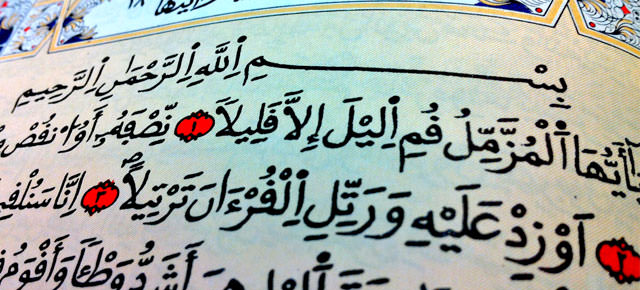By Chaplain Marc Manley who writes on www.marcmanley.com
The following are some loose notes from a talk I delivered at the University of Pennsylvania on March 12th, 2012, on the topic of qira’at al-Qur’an or the Recitations of the Qur’an.
I will try to provide some succinct information on some of the terminology, also known as istilahat [اصطلاحات] as well as the various qurra’ [قراء] or reciters.
Keep supporting MuslimMatters for the sake of Allah
Alhamdulillah, we're at over 850 supporters. Help us get to 900 supporters this month. All it takes is a small gift from a reader like you to keep us going, for just $2 / month.
The Prophet (SAW) has taught us the best of deeds are those that done consistently, even if they are small.
Click here to support MuslimMatters with a monthly donation of $2 per month. Set it and collect blessings from Allah (swt) for the khayr you're supporting without thinking about it.
When we say there is a qira’ah of the Qur’an, what we mean is really three things:
- Qira’ah [قراءة]: it is that which relates to one of the Ten Reciters, aqari’ [قاريء]. These Ten are sometimes known as al-‘Ashr al-Ma’rifun [العشر المعرفون]. For example, Imam ‘Asim and Imam Ibn Kathir are from this group. Each of the Seven Reciters [known for their chains of narration [sanad], which are mutawatir, had two students [the next group].
- Riwayah [رواية]: it is that which relates to one of the narrators, arawin [راو]. These narrators took the recitation from the above group and dispersed it. Such examples might be Hafs ‘an ‘Asimor al-Susi ‘an Abi ‘Amru, with ‘Asim and Abu ‘Amru being the teachers of Imam Hafs and Imam al-Susi respectively. Think of it as student ‘an teacher [الطالب عن شيخه].
- Tariq []: these are in a sense the students of the rawaya [روايا أو راويون] narrators. An example of this might be a mushaf[physical copy of the Qur’an] which was the title of Khalaf ‘an Hamzah ‘ala Tariq al-Shatibiyyah, or Khalaf, the student of Imam Hamzah from the chain of al-Shatibiyyah. For time’s sake, we will not be delving into al-Azraq or al-Shatibiyyah but do know that there is this third component.
The Seven Reciters are:
- Imam Nafi’: his two students were Warsh and Qalun. Therefore you have the recitation of Wash ‘an Nafi’ or Qalun ‘an Nafi’. Imam Nafi’ is from the Madinah school.
- Imam Ibn Kathir: his two students were al-Bazzi and Qunbul [incidentally, these are sometimes also pronounced al-Buzzi and Qanbal]. Their recitations are known as al-Bazzi ‘an Ibn Kathir and Qunbul ‘an Ibn Kathir. Ibn Kathir is from the Makkah school.
- Imam Abu ‘Amru: his two students were al-Susi and al-Duri*. Their recitations are known as al-Susi ‘an Abi ‘Amru and al-Duri ‘an Abi ‘Amru. Abu ‘Amru is from the ‘Iraqi school [al-Kufah].
- Imam Ibn ‘Amir: his two students were Hisham and Ibn Dhakwan. Their recitations are known as Hisham ‘an Ibn ‘Amir and Ibn Dhakwan ‘an Abi ‘Amir.
- Imam ‘Asim: his two students were Hafs and Shu’bah. Their recitations are known as Hafs ‘an ‘Asim [the most commonly recited narration today] and Shu’bah ‘an ‘Asim. Imam ‘Asim is also from the Kufic school of ‘Iraq.
- Imam Hamzah: his two students were Khalaf and Khallad. Their recitations are Khalaf ‘an Hamzah and Khallad ‘an Hamzah. Imam Hamzah is also from the Kufic ‘Iraqi school.
- Imam al-Kisa’i: his two students were Abu al-Harith and al-Duri*. Their recitations are Abu al-Harith ‘an al-Kisa’i andal-Duri ‘an al-Kisa’i. Imam al-Kisa’i is also from the Kufic ‘Iraqi school.
* al-Duri is the only student to have taken narrations from two Master Reciters: Abu ‘Amru and al-Kisa’i.
The Three Mash’hur Reciters:
- Abu Ja’far.
- Ya’qub.
- Khalaf.
Three major conditions for being classified as a qira’ah:
- Sound chain of narration: narrators were continuous, well known for their piety and were known to possess Sound memories. The recitation must also be dispersed by a large number of narrators after the Sahabah [this is the condition of mutawatir]. Narrations which did not fit this stringent category were considered eithermash’hur [as in the case of Abu Ja’far, etc.] or irregular [shaddh].
- The recitation had to match the grammatical rules and constructions of the Arabic language. This was acceptable even if they matched styles found in the Jahiliyyah poetry [pre-Islamic poetry].
- The narration had to agree with the script of one of the copies of the Qur’an disseminated by Khalif ‘Uthman Ibn ‘Affan in the ‘Uthmani script [al-Rasm al-Uthmani/الرسم العثماي]. This is why it is acceptable to have differences in the “dot placement” (تعلمون أويعلمون) so long as the other conditions are met.



























Amad
September 22, 2013 at 3:25 AM
jazakallahkhair Brother Marc…